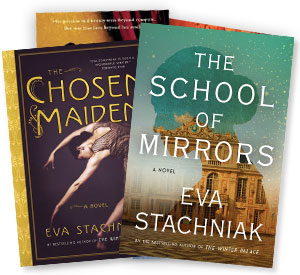William Wadsworth
The Winter Palace
by Eva Stachniak
DoubledayToronto-based historical novelist Eva Stachniak first carved a niche in the study of deceit in 2000, with Necessary Lies, an award-winning story of marital betrayal in modern Poland.
In The Winter Palace, Polish-born Stachniak brings out the laudanum and belladonna, the smoke, mirrors and creaking bedsteads for another sassy immigrant success story, set in the 18th-century Russian court.
Now No2 on the Globe & Mail’s fiction hardback list, The Winter Palace is billed as ‘A Novel of Catherine the Great’, but it’s really a tale of how two bright immigrant teenagers team up for survival in snake-pit salons over the next 20 years. Stachniak quickly establishes her principal characters with Conradian clarity, and the pages of The Winter Palace fly by as its central character, Barbara, leaves her native Poland for St Petersburg, where her bookbinder father cultivates her literacy and repairs the libraries of Russia’s nobility.
When the multilingual Barbara is orphaned, Stachniak captures the teenager’s insecurity in the palace as a Cinderella-type seamstress ward of the court. Scorned by gossipy colleagues as an outsider, Barbara feels her talents are wasted in frozen attics, until her unexpected storeroom meeting with Russian chancellor Count Bestuzhev, who is soon impressed by her education, knowledge of palace tittle-tattle and young curves. As readers might expect in bodice-ripper-lit, the chancellor seduces Barbara, and then teaches the eager youngster how to become a palace spy.
The highlight of The Winter Palace is where Stachniak describes, in short, seemingly whispered sentences, how Barbara learns where to peep, pick locks, hide letters and tell half-truths in a world where careless words literally cost lives. Under Bestuzhev’s tutelage, Barbara – now Russianised as Varvara – wins the confidence of the worldly Empress Elizabeth and is sent to assist and spy on Crown Prince Peter, her wet, pro-Prussian teenage nephew and heir. Varvara’s loyalties are tested when the prince marries the teenaged Princess Sophie of Anhalt-Zerbst-Dornburg, however. While Peter ignores Sophie, Varvara befriends the broke and lonely German immigrant, now named Catherine, and becomes her spy instead.
Catherine the Great’s rise to power and Peter’s fate are well known, thanks to the success of Robert Massie’s best-selling Catherine the Great: Portrait of a Woman (see page 15) and several more biographies and films, but Stachniak’s well-researched fiction shows how Varvara’s schemes could have influenced history. She sets her heroine’s subterfuge between convincing glimpses of the seasonal food, colour, superstitions and smells of St Petersburg. She brings to life the whispers of servants and the rustle of soon-discarded skirt hoops, silks and brocade, and even includes courtiers’ frustrations at their long wait to move into architect Bartolomeo Rastrelli’s new palace.
The author also captures the discovery and fate of discarded courtiers, the gush of royal entourages and the physical decline of the cat-loving, man-eating Elizabeth. Stachniak’s giggly Catherine becomes increasingly ethereal in The Winter Palace, however, as if to remind Varvara and readers to hang on the distant royal’s every word.
The author hurries through Catherine’s coup and misses the chance to contrast wily-girly court talk with battle scenes involving key male characters, as Tolstoy did, but Stachniak ably conveys Varvara’s reliance on her protector, and her efforts to read between the lines of her messages.
Varvara’s future seems secure, but she becomes complacent at court, and the final 100 pages of this film-ready peephole fantasy are so gripping that its ending is almost anti-climactic.
Stachniak is already working on a Catherine sequel.

Polish Language Site